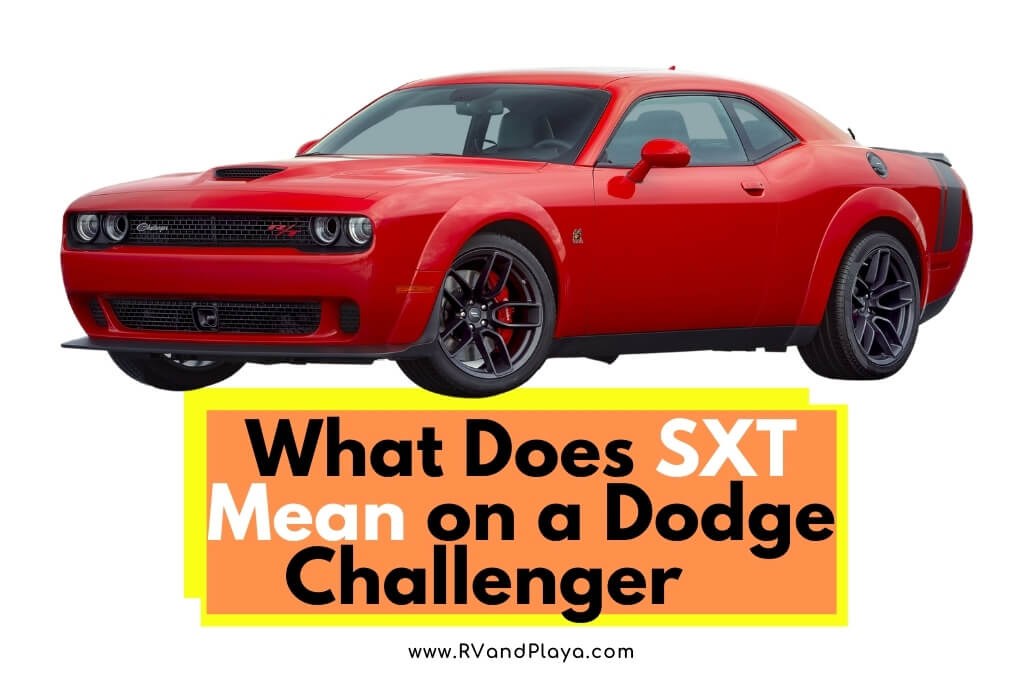If you’re looking at a Dodge Challenger as your next car, you might find yourself a bit overwhelmed by all of the different trim levels available. SXT, GT, R/T, SRT… these letters don’t really tell you much on their own, and unless you’re a car expert you might have no idea where each of these trims ranks within the Challenger hierarchy.
So, what does SXT mean on a Dodge Challenger? The SXT means Standard XTra on Dodge Challenger. Put simply, the SXT trim level is the most basic trim level available for the Challenger. With the SXT trim level, you’ll miss out on some of the other stuff that would be available to you at higher trim levels, but the upside is that the SXT Challenger is less expensive as a result.
In this article, we’ll be giving you an overview of the Challenger model and explaining what exactly the SXT trim level includes and what you have available as an option.
Dodge Challenger Overview
Before we go over the specifics of the Challenger SXT, let’s check out the Challenger in general and see what you’re getting.
The Dodge Challenger has been in production since 1970, but since that time there have only been three generations of the Challenger produced.
The first generation, produced from 1970 to 1974, was a truly iconic vehicle and one of the most famous muscle cars ever made, while the second generation, produced from 1978 to 1983, was nothing more than a rebadged Mitsubishi Galant.
Not only this, but the second-generation Challenger wasn’t available with a V8 or even a six-cylinder; the only engine options available were a couple of naturally-aspirated inline fours.
As you can imagine, the second-generation Challenger failed to make any kind of lasting impression on the car world.
It wasn’t until 2008 that Dodge brought the Challenger name back for a new car, this one arguably a lot more fitting of the name.
The design of the third-generation Challenger was heavily inspired by the original 1970 Challenger and brought back the big V8s that the Challenger was known for having back in the day.
Currently, the Challenger is available with multiple engine options, including the Pentastar V6 and three different HEMI V8 engines.
Since 2008, the Challenger has been facelifted once, and multiple new trim levels have been introduced, including the high-performance Hellcat and Demon variants.
Read also: What Does SXT Mean For a Dodge Caravan? (Explained)
Dodge Challenger SXT Features
Now that you have a general idea of what the Challenger is about, let’s talk about what you can expect from a Challenger SXT.
As we’ve already mentioned, the SXT is the base trim level for the Challenger, meaning it has the fewest available features of any of the Challenger models, but it’s also the least expensive as a result.
In this section, we’ll be going over the features of the Challenger SXT and explaining what you get as standard and what’s available to you as options.
Powertrain Options
If you’re opting for the Challenger SXT, you’ll unfortunately be pretty limited in terms of the powertrain options that are available to you. There’s only one engine available for the SXT, which is the Pentastar V6 that’s also found in a lot of other Dodge vehicles.
Compared to the V6 in other Dodge models, however, the V6 in the Challenger SXT is in a slightly higher stage of tune. The V6 in the SXT makes 303 hp and 268 lb-ft of torque, which is enough to take the SXT from 0-60 in 5.3 seconds, a pretty respectable time for a base-level sports car.
There’s also only one transmission option for the SXT, which is Dodge’s TorqueFlite eight-speed automatic. The TorqueFlite is actually a rebranded version of the ZF 8HP transmission, which is generally known to be a pretty reliable transmission that can handle a lot of power.
You do get one option when speccing your powertrain, however; you can choose between a rear-wheel drive and an all-wheel-drive layout.
You’ll get the same 0-60 time regardless of which layout you pick, so the all-wheel-drive option really only exists for those who want better handling.
While the Pentastar V6 isn’t as beefy as any of the V8s that Dodge offers for its other Challenger models, it’s by far the most fuel-efficient engine in the Challenger lineup.
Dodge promises 23 mpg (12.4 L/100 km) during city driving and 36 mpg (7.8 L/100 km) during highway driving for an average of about 29 mpg (8.1 L/100 km).
Exterior Styling Options
The Challenger SXT comes with a decent amount of opportunity for visual customization. For starters, you have a selection of thirteen different paint colors to choose from for your exterior color, and of these thirteen, only five require an additional cost. The rest are included in the base price of the car.
You also get a few options for the wheels you can have. The standard wheels are 18″ aluminum wheels finished with “Satin Carbon” paint, but you can also upgrade to 20″ aluminum wheels finished in either “Satin Carbon” or “Black Noise”.
If you want, you can also upgrade your SXT even further to include the “Blacktop” package, which comes with lots of visual touches including a racing stripe, a blacked-out rear badge, a black grille, a black rear spoiler, and a black fuel filler door.
The package also includes fog lamps, center caps for the wheels, and the aforementioned “Black Noise” 20″ wheels. It also includes a few modifications to the interior trim that we’ll discuss in the next section.
Interior Styling Options
The Challenger SXT offers a solid amount of customization options for the interior, at least compared to other Dodge models.
For starters, you have three possible interior color combinations, which include black on black, black with caramel inserts, and black with ruby inserts.
The default seat material is cloth, but you can upgrade to napa leather seats if you want. You can also choose between bucket seats and sport seats.
If you get the “Blacktop” package that we previously mentioned, you get a few other interior upgrades as well, including a leather-wrapped steering wheel and black trim rings for the gauge cluster.
Equipment Options
The Challenger SXT doesn’t come with too much equipment as standard, but you have the option of adding a lot of features if you want. The SXT does come standard with some handy stuff like a backup camera, support for both Apple CarPlay and Android Auto, and a 7″ touchscreen multimedia display.
Again, though, you have the opportunity to add tons of options on top of these. For example, you could opt for the “Driver Convenience” options group, which includes blindspot monitoring, a remote start system, and heated mirrors.
Or you could go for the “Technology” group which includes adaptive cruise control and forward-collision warning.
You can also upgrade your 7″ touchscreen to an 8.4″ touchscreen if you want, and on top of that, you can add GPS navigation to your SXT as well.
Other upgrades include swapping out the basic cloth seats for leather seats with heating, ventilation, and memory settings, as well as a power sunroof, an improved sound system, and the inclusion of a compact spare tire.
While it is great that these options are available for the SXT, keep in mind that if you go ham with these option packages then the price of your car is going to shoot way up.
In this case, you might want to consider buying one of the higher trim levels where more of these options are included as standard.
Here are some of my favorite tools & equipment´s
Thank you for reading this article. I hope it helps you find the most recent and accurate technical and repair information for your car. Here are some tools that I use as an automotive technician and hope you´ll also find helpful.
There are affiliate links, so if you do decide to use any of them, I´ll earn a small commission. But in all honesty, these are the exact tools that I use and recommend to everyone, even my own family. (NO CRAP)
To see all my of most up-to-date recommendations, check out this resource that I made for you!
References
https://www.dodge.ca/en/challenger/models
Recent Posts
Have you ever wondered what does SXT means for a Dodge Caravan? Well, look no more. We´ve got you covered. If you are looking to buy a new minivan, you’ve likely been entranced by the Dodge...
What Is The Camper Package On Ford F450? Facts You Should Know
The brilliant thing about owning a Ford Truck is that, in many cases, you can purchase an 'upgrade' to the vehicle that will allow you to attach a slide-on camper. The Ford F450, one of the most...


